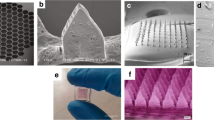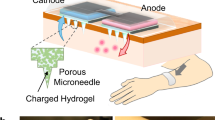Abstract
It has recently been proposed that the combination of skin barrier impairment using microneedles (MNs) coupled with iontophoresis (ITP) may broaden the range of drugs suitable for transdermal delivery as well as enabling the rate of delivery to be achieved with precise electronic control. However, few reports exist on the combination of ITP with in situ drug-loaded polymeric MN delivery systems. Our in vitro permeation studies revealed that MN enhances transdermal drug delivery. The combination of dissolving MN and ITP did not further enhance the extent of delivery of the low molecular weight drug ibuprofen sodium after short application periods. However, the extent of peptide/protein delivery was significantly enhanced when ITP was used in combination with hydrogel-forming MN arrays. As such, hydrogel-forming MN arrays show promise for the electrically controlled transdermal delivery of biomacromolecules in a simple, one-step approach, though further technical developments will be necessary before patient benefit is realized.
Access this chapter
Tax calculation will be finalised at checkout
Purchases are for personal use only
Similar content being viewed by others
References
Prausnitz MR (2004) Microneedles for transdermal drug delivery. Adv Drug Deliv Rev 56(5):581–587
Banga A (2007) Transdermal delivery of proteins. Pharm Res 24:1357–1359
Migalska K, Morrow DI, Garland MJ, Thakur R, Woolfson AD, Donnelly RF (2011) Laser-engineered dissolving microneedle arrays for transdermal macromolecular drug delivery. Pharm Res 28(8):1919–1930
Kaushik S, Allen H, Donald D et al (2001) Lack of pain associated with microfabricated microneedles. Anesth Analg 92:5024
Bal SM, Caussin J, Pavel S, Bouwstra JA (2008) In vivo assessment of safety of microneedle arrays in human skin. Eur J Pharm Sci 35(3):193–202
Van Damme P, Oosterhuis-Kafeja F, Van der Wielen M et al (2009) Safety and efficacy of a novel microneedle device for dose sparing intradermal influenza vaccination in healthy adults. Vaccine 27(3):454–459
Wilke N, Mulcahy A, Ye S, Morrissey A (2005) Process optimization and characterization of silicon microneedles fabricated by wet etch technology. Microelectron J 36:650–656
McAllister DV, Wang PM, Davis SP et al (2003) Microfabricated needles for transdermal delivery of macromolecules and nanoparticles: fabrication methods and transport studies. Proc Natl Acad Sci U S A 100(24):13755–13760
Cormier M, Johnson B, Ameri M et al (2004) Transdermal delivery of desmopressin using a coated microneedle array patch system. J Control Release 97(3):503–511
Sullivan SP, Murthy N, Prausnitz MR (2008) Minimally invasive protein delivery with rapidly dissolving polymer microneedles. Adv Mater 20(5):933–938
Chu LY, Choi SO, Prausnitz MR (2010) Fabrication of dissolving polymer microneedles for controlled drug encapsulation and delivery: bubble and pedestal microneedle designs. J Pharm Sci 99(10):4228–4238
Donnelly RF, Majithiya R, Singh TR et al (2011) Design, optimization and characterisation of polymeric microneedle arrays prepared by a novel laser-based micromoulding technique. Pharm Res 28(1):41–57
Lanke SS, Kolli CS, Strom JG, Banga AK (2009) Enhanced transdermal delivery of low molecular weight heparin by barrier perturbation. Int J Pharm 365(1–2):26–33
Wang Y, Thakur R, Fan Q, Michniak B (2005) Transdermal iontophoresis: combination strategies to improve transdermal iontophoretic drug delivery. Eur J Pharm Biopharm 60(2):179–191
Katikaneni S, Badkar A, Nema S, Banga AK (2009) Molecular charge mediated transport of a 13 kD protein across microporated skin. Int J Pharm 378(1–2):93–100
Wu XM, Todo H, Sugibayashi K (2007) Enhancement of skin permeation of high molecular compounds by a combination of microneedle pretreatment and iontophoresis. J Control Release 118(2):189–195
Chen H, Zhu H, Zheng J et al (2009) Iontophoresis-driven penetration of nanovesicles through microneedle-induced skin microchannels for enhancing transdermal delivery of insulin. J Control Release 139(1):63–72
Vemulapalli V, Yang Y, Friden PM, Banga AK (2008) Synergistic effect of iontophoresis and soluble microneedles for transdermal delivery of methotrexate. J Pharm Pharmacol 60(1):27–33
Kalluri H, Banga AK (2011) Formation and closure of microchannels in skin following microporation. Pharm Res 28(1):82–94
Williams AC (2003) Transdermal and topical drug delivery. Pharmaceutical Press, London
Garland MJ, Singh TR, Woolfson AD, Donnelly RF (2011) Electrically enhanced solute permeation across poly(ethylene glycol)-crosslinked poly(methyl vinyl ether-co-maleic acid) hydrogels: effect of hydrogel crosslink density and ionic conductivity. Int J Pharm 406(1–2):91–98
Mukerjee EV, Collins SD, Isseroff RR, Smith RL (2004) Microneedle array for transdermal biological fluid extraction and in situ analysis. Sens Actuat A Phys 114:267–275
Author information
Authors and Affiliations
Editor information
Editors and Affiliations
Rights and permissions
Copyright information
© 2014 Springer Science+Business Media, New York
About this protocol
Cite this protocol
Donnelly, R.F., Garland, M.J., Alkilani, A.Z. (2014). Microneedle-Iontophoresis Combinations for Enhanced Transdermal Drug Delivery. In: Jain, K. (eds) Drug Delivery System. Methods in Molecular Biology, vol 1141. Humana Press, New York, NY. https://doi.org/10.1007/978-1-4939-0363-4_7
Download citation
DOI: https://doi.org/10.1007/978-1-4939-0363-4_7
Published:
Publisher Name: Humana Press, New York, NY
Print ISBN: 978-1-4939-0362-7
Online ISBN: 978-1-4939-0363-4
eBook Packages: Springer Protocols




